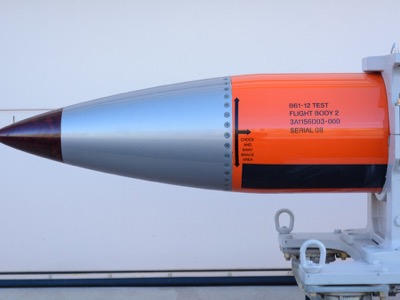“THE ART OF WAR”
The Bomb is Authorized
The B61-12, the new US nuclear bomb intended to replace the B-61s lined up in Italy and other countries, has been “officially authorized” by the National Nuclear Security Administration (NNSA), the Department of Energy Agency assigned to “strengthen national security through the military application of nuclear science”.
After four years of planning and tests, the NNSA has given the green light to the engineering phase that prepares for mass production. The B61-12’s many components are designed and tested in the national laboratories of Los Alamos and Albuquerque (New Mexico), Livermore (California) and manufactured (using some parts of the B-61) in a group of plants in Missouri, Texas, South Carolina and Tennessee. The section of the tail for precision guidance, manufactured by Boeing, is added to this.
The B61-12, the cost of which is forecast at 8-12 billion dollars for 400-500 bombs, will start to be mass-produced in the tax year 2020 (starting 1 October 2019). From that point on, the B-61 will start to be replaced.
The Federation of American Scientists (FAS) estimates that today the US has a total of 180 nuclear bombs in Europe: 70 B-61 nuclear bombs in Italy (50 at Aviano and 20 at Ghedi-Torre); 50 in Turkey; and 20 in each of Germany, Belgium and Holland. However no one knows precisely how many there actually are: at Aviano, there are 18 bunkers with the capacity to store another 70. Changes have already been made to both the Aviano and Ghedi bases, as the satellite photos published by the FAS show. Similar preparations are underway at the other bases in Europe and Turkey.
The NNSA officially confirms that the B61-12, defined as the “lynchpin of the US nuclear triad” (land, sea and air), will replace the existing B61-3, -4, -7 and -10. This therefore confirms what we have already reported. The B61-12 is not simply an updated version of the previous model but a weapon sui generis:
• a nuclear head where one of four power options can be selected, with an average power that equals four Hiroshima bombs;
• a guiding system that enables it to be launched at a distance from the target; and
• the capability to penetrate ground level to destroy command centre bunkers in a surprise nuclear attack.
The new bombs that the US is preparing to install in Italy and other European countries in the context of the escalation against Russia, are weapons that lower the nuclear threshold and by doing so, increase the probability of a nuclear attack being launched.
The 31st Fighter Wing, the squadron of the US F-16 fighter bombers deployed at Aviano, is ready for nuclear attack, 24/7. The FAS shows that Italian pilots have also been trained for a nuclear attack under US command with the Tornado fighter bombers at Ghedi. In anticipation, the F-35 fighters also arrive at the Italian Air Force, into which, the US Air Force announces, “the B61-12 will be integrated”.
The first F-35 squadron, stored at the Hill base in Utah, has been officially declared “ready for combat”. The US Air Force says that it cannot say when the F-35 squadron will be “combat proven”, but that an “overseas line up is probable at the beginning of 2017”.
Minister Pinotti hopes that it is stored in Italy, which the US has already “chosen” to install MUOS, something “other nations would have wanted”.
As Italy has the B61-12, the F-35 and the MUOS on its territory, it will also be selected by the country attacked as a priority target for a nuclear reprisal.
Translation
Anoosha Boralessa
Anoosha Boralessa
Source
Il Manifesto (Italy)
Il Manifesto (Italy)

